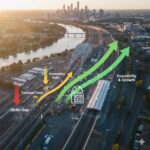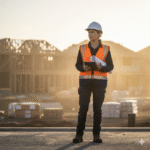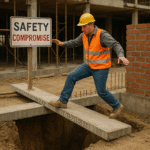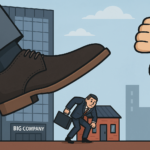|
Getting your Trinity Audio player ready...
|
How workplace culture and misguided safety policies created a 15-year nightmare for one Australian construction worker – and what it teaches us about the real cost of getting safety wrong.
Fair dinkum, when I sat down with Conrad Wanssborough for the You Are Epic podcast, I thought we’d be talking about safety systems and high-risk work environments. What I got instead was one of the most gut-wrenching examples of how our industry’s obsession with statistics over humanity destroys lives. Conrad’s story isn’t just about one workplace injury – it’s about how well-intentioned safety policies can create the very disasters they’re meant to prevent.
Fifteen years on from a workplace injury that should never have happened, Conrad still lives with chronic pain every single day. But here’s the kicker – it wasn’t just bad luck or unavoidable risk that put him in that position. It was a series of upstream decisions made by people sitting in office buildings, far removed from the workface, who prioritized productivity over people.
When Zero Harm Policies Create Real Harm
Conrad’s injury happened in 2010 on an offshore project where he was working as a safety supervisor. The irony isn’t lost on anyone – the safety bloke getting seriously hurt because of safety policy. But this wasn’t a case of “do as I say, not as I do.” This was a textbook example of how zero-harm policies create perverse incentives that put workers in danger.
“They had a zero-harm policy,” Conrad explained during our chat. “They had we don’t want to see any injuries. All injuries are preventable, and we’re counting how many days we haven’t had any injuries. So that is an upstream philosophy that they’re pushing downstream.”
The trouble started with something as simple as dust in a worker’s eyes. The bloke was doing his job, safety specs and all, but some dust got behind the glasses anyway. Basic first aid sorted it – an eyewash, problem solved. It should have been the end of it. But in a zero-harm environment, even the most minor incident becomes a major drama because it threatens those precious statistics that companies use to win tenders and keep insurance premiums down.
Here’s where it gets really twisted. The company had two options to prevent similar incidents: wash down all the I-beams and ledges to eliminate the dust hazard (which meant standing down 80 people for 2-3 hours), or wrap everyone up in “big fat mono goggles” that fogged up in 40-degree heat. Guess which option they chose? The one that didn’t hurt productivity, even though it created new hazards.
Conrad saw it coming. “A month beforehand, I remember on this gig, I was going, ‘Someone’s going to get hurt.’ Decisions were made on the fly by people that had no idea or no connection to the work front. They’re in an office building making decision for people that were working offshore, a remote environment doing very high-risk work.”
But like so many of us in construction, Conrad didn’t walk away. He had a new family, a mortgage, the usual pressures that keep us grinding even when our gut tells us something’s not right. “I didn’t quit. I had a new family. I was just a year into my marriage, and I thought the money’s so good. If I quit now, I’m going to risk my house, risk the family that I’ve got going. I just wanted to provide.”
Sound familiar? How many times have we all been in that exact position – knowing something’s not right but staying put because we’ve got bills to pay and people counting on us?
The Injury That Changed Everything
When Conrad finally got hurt, it wasn’t from some dramatic accident you’d see in a safety video. It was the result of that earlier decision to prioritize statistics over sensible hazard control. The company chose short-term productivity over worker safety, and Conrad paid the price with a complex neck injury that would alter the course of his entire life.
“I lost muscle groups in the back of my arm. I was in intense pain. I was having difficulty with the rest of my body. I was unable to dress myself. I eventually ended up with spinal surgery and getting a disc replacement in my neck,” he told me, the weight of those memories still evident in his voice.
But the physical injury was just the beginning. Conrad’s recovery journey reveals the hidden costs of workplace injuries that most companies never factor into their risk assessments. We talk about lost time injury rates like they’re just numbers on a spreadsheet, but behind every statistic is a human being whose world has been turned upside down.
“My dad says I lost 80% of my personality,” Conrad shared. “I was very outdoorsy, I was adventurous. I’d been a sailor, I’ve sailed to Antarctica across the Pacific and Atlantic oceans, and that just left my life. It was hard enough walking up a flight of stairs.”
Think about that for a minute. This bloke went from sailing across oceans to struggling with a flight of stairs. That’s not just a workplace injury – that’s a complete life derailment.
The Seven-Year Sentence
The operation was technically successful. Conrad got his physicality back, his muscle groups returned, but he kept the pain. For seven years, chronic pain became his constant companion, affecting every aspect of his life in ways that most of us can’t imagine.
“In those six, seven years, it was foreground pain. I couldn’t function effectively with that pain. It was always in the front of my mind. It was always there. When you wake up, you’re instantly awake because pain is right there,” he explained.
But perhaps even more devastating was the loss of community. Conrad’s entire social network was built around the very activities his injury had stolen from him. His climbing mates, his outdoor adventure crew, his FIFO work colleagues – they all disappeared, not because they didn’t care, but because their lives had moved on while his had stopped.
“There was also the biggest thing, which was the loss of my community, my work friends, my climbing friends, my outdoors friends, just dropped off because I’m not involved in the same activities,” Conrad reflected. “When you work FIFO or fly in fly-out, that community is all over the world. It was a niche industry where people would work with the same people over and over again.”
This hits at something we don’t talk about enough in construction. Our industry creates tight-knit communities forged by shared experiences in challenging environments. When injury breaks that connection, the isolation can be crushing. It’s not just about the physical recovery – it’s about rebuilding an entire identity and social network from scratch.
Mental Health: The Silent Crisis on Australian Construction Sites
Treated Like a Criminal
If the injury and chronic pain weren’t enough, Conrad’s experience with the workers’ compensation system added insult to literal injury. What should have been a supportive process to help him recover and return to work became an adversarial nightmare that treated him like a criminal trying to rip off the system.
“After your injury goes from the prospect of returning to work to being a long-term problem, you’re treated as a criminal in some respects. You’ve got people going past with cameras hanging out of their car taking photos of me on my front step of my house to see if I was faking it,” Conrad recalled.
This surveillance mentality is endemic in our workers’ compensation systems. Instead of focusing on healing and recovery, the emphasis becomes on catching people out, proving they’re not as injured as they claim. Conrad’s analogy perfectly captures the madness of it all:
“The analogy would be you crash a car, the panels are dented, the engine’s stuffed, the radiator’s busted, the insurance looks at it and goes, ‘It’s a write-off. We’re going to get you another one. We’ll pay you out, or we’re going to fix it.’ If it’s a human being, they look for the human aspects to discredit the human being to reduce the cost impact to the insurance.”
This treatment of injured workers as problems to be minimized rather than people to be healed creates secondary trauma that can last longer than the original injury. It’s a systemic failure that reflects deeper cultural issues about how we value human life versus productivity in our industry.
The Ongoing Impact: Fifteen Years Later
Today, Conrad has built a successful career helping organizations create genuinely safe workplaces. He’s turned his painful experience into expertise that benefits others. But the impact of that 2010 injury hasn’t disappeared. He still carries chronic pain, a daily reminder of how one bad decision can echo through decades.
“Still does,” he confirmed when I asked about the ongoing impact. “I’ve still got the residual chronic pain that’s associated with that. The operation was a success as in I got my physicality back. My muscle groups grew back. My arm went down to normal. Wasn’t hooked up anymore. But I kept the pain.”
This is the reality behind our industry statistics. Every lost time injury represents a human story like Conrad’s – lives permanently altered by decisions made in boardrooms by people who will never face the consequences of their choices.
What Conrad’s Story Teaches Construction Leaders
Conrad’s experience reveals fundamental flaws in how our industry approaches safety. We’ve created systems that measure the wrong things, incentivize the wrong behaviours, and treat workers as problems rather than partners in creating safe workplaces.
The zero-harm policy that contributed to Conrad’s injury perfectly illustrates this dysfunction. On the surface, zero harm sounds admirable – who doesn’t want zero injuries? But in practice, it often creates a culture of hiding, under-reporting, and making stupid decisions to protect statistics rather than people.
“Lost time injury rates are about having one or more shifts off work rather than looking at the severity and the impact of the harm. It’s a quantity-based assessment. It’s got nothing to do with safety. It’s about productivity,” Conrad explained. “It should be called lost productivity rather than lost time. It’s not safety. It’s not a safety measure.”
This obsession with lagging indicators – counting injuries after they happen – tells us nothing about how safe our workplaces actually are. It’s like trying to judge the quality of your driving by counting car crashes rather than looking at road conditions, vehicle maintenance, and driver skills.
Conrad advocates for a fundamental shift: “If you’re measuring quantity of things, you’ll never understand the quality of safety in the organization. You’ll never understand how much safety is being created or how close you are to having a significant or fatal accident. You’ll never see it coming.”
The Power Imbalance That Kills
One of the most insightful aspects of Conrad’s analysis is how he identifies the power imbalance between management and frontline workers as a fundamental safety issue. Too often, safety systems are designed on the assumption that managers are smart and workers are stupid, leading to compliance-heavy approaches that ignore frontline expertise.
“A lot of the time, concentrating on the behaviours of people is setting up a power imbalance. It’s saying managers or leaders are smart and people at the front line are stupid. Try and catch them out and report them in as something you’ve done to correct bad behaviour,” Conrad observed.
But here’s the thing – the people actually doing the work know more about the real risks and practical solutions than anyone sitting in an office. They’re the ones dealing with the hazards day in, day out. They understand what works and what doesn’t in ways that safety management systems often miss entirely.
“The people at the front line have very high levels of expertise in what they do, the equivalent of the same expertise that executives have in what they do. It’s just different – a different trade,” Conrad noted. “Stop imposing compliance on people at the front line and start asking what do they need.”
This insight is revolutionary for how we think about safety culture. Instead of top-down compliance systems, we need bottom-up capability building. Instead of catching people out, we need to ask what tools and systems they need to do their jobs safely.
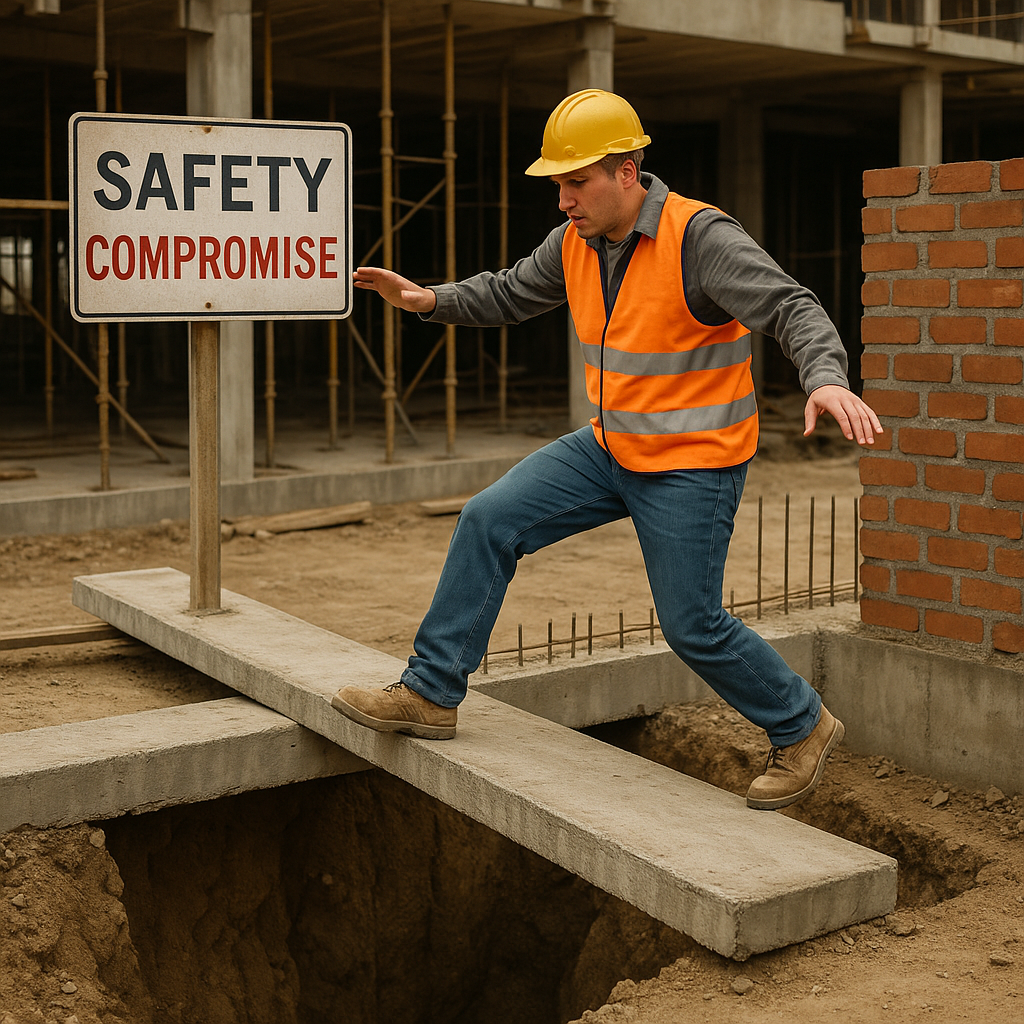
Context Drives Behaviour: The Human Side of Safety
Perhaps the most powerful insight from Conrad’s experience is his understanding that good people can make bad decisions when the context forces their hand. “Everyone goes to work wanting to do the right thing. Very few, if any, people go to work to intentionally harm other people. However, the context drives behaviour.”
Conrad’s own decision to stay on that job despite his concerns illustrates this perfectly. He wasn’t reckless or careless – he was trying to provide for his new family in an industry where walking away from good money isn’t always an option. The context – financial pressure, industry norms, limited alternatives – drove his behaviour more than any safety policy ever could.
“If we’re all overworked, if our demands exceed our resources to manage those demands, then behaviours change unconsciously,” Conrad explained. This is why focusing solely on individual behaviour misses the point. If the system is broken, even the best people will eventually break within it.
Building Human-Centred Safety Systems
Conrad’s journey from injured worker to safety expert has given him unique insights into what actually creates safe workplaces. His approach focuses on humanity rather than compliance, quality rather than quantity, and capability rather than control.
“How do we create ethically and morally safe workplaces rather than just looking at the injury side?” he asks. The answer isn’t more procedures or stricter enforcement – it’s genuinely understanding what people need to do their jobs safely and providing those things.
This means designing every tool, every process, every system to enable safe work rather than just document compliance. “If you want to design an organization for safe outcomes, design every artifact, every function to feed in, to enable workers to produce safe outcomes. Compliance will fall out of doing that anyway,” Conrad advises.
It also means treating injured workers as human beings rather than problems to be minimized. Conrad advocates for “healing the harm” rather than managing the cost – a fundamental shift in how we approach injury management that could prevent much of the secondary trauma he experienced.
The Ripple Effect of Cultural Change
Conrad’s story demonstrates the ripple effect that workplace culture decisions have on real lives. One policy decision made in a corporate office created a chain of events that altered the trajectory of a human life for fifteen years and counting. But the same principle works in reverse – better decisions create positive ripples that protect and enable people.
This is why the work we do in construction culture change matters so much. Every policy we help organizations redesign, every leader we coach to think differently about safety, every conversation we facilitate about real workplace issues has the potential to prevent another story like Conrad’s.
The construction industry has a choice. We can continue with systems that prioritize statistics over people, compliance over capability, and control over collaboration. Or we can learn from stories like Conrad’s and build workplaces that truly put people first.
Moving Forward: Lessons for Australian Construction
Conrad’s experience offers several critical lessons for how we can do better:
Stop measuring the wrong things. Lost time injury rates don’t tell us how safe our workplaces are – they tell us how good we are at hiding problems. Quality measures that assess how well we’re enabling safe work are far more valuable than quantity measures that count failures after they happen.
Trust frontline expertise. The people doing the work know more about real risks and practical solutions than anyone else. Instead of imposing compliance systems, ask what they need to work safely and provide those things.
Design systems for humans. Every policy, procedure, and system should enable safe work rather than just document compliance. If it doesn’t help people do their jobs better and safer, it’s probably making things worse.
Treat injured workers as human beings. The workers’ compensation system’s adversarial approach creates secondary trauma that often lasts longer than the original injury. Focusing on healing rather than cost management could transform outcomes for everyone.
Understand that context drives behaviour. Good people make bad decisions when systems force their hand. Creating better contexts – through adequate resources, reasonable timelines, and genuine support – prevents more injuries than behavioural enforcement ever will.
Recognize the hidden costs. Every workplace injury creates ripple effects that extend far beyond the immediate medical costs. Loss of community, identity, and social connection can be just as devastating as physical trauma.
Conrad’s transformation from injured worker to safety expert shows that even the most painful experiences can drive positive change. But we shouldn’t need people to sacrifice their health and well-being to teach us these lessons. We can choose to learn from their experiences and build better systems for everyone who comes after.
The seven-year price Conrad paid for one bad decision is a cost too high for any worker to bear. By understanding his story and applying its lessons, we can prevent others from paying the same price. That’s not just good business – it’s our moral obligation to the people who build Australia.
